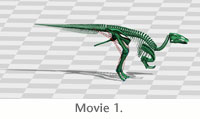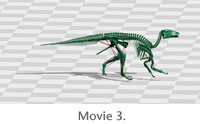Results
 All runs produced effective forward gait but there was a surprisingly large variation in the gaits generated and the maximum speeds.
Table 2 summarizes the results. All runs produced effective forward gait but there was a surprisingly large variation in the gaits generated and the maximum speeds.
Table 2 summarizes the results.
 The quadrupedal model never generated a completely bipedal run but in 3 out of 10 occasions the contribution of the forelimb was minimal: brushing along the ground momentarily at some point in the gait cycle. The other seven gaits generated were quadrupedal, and the full range of symmetrical gaits were demonstrated: trot, pace and single foot (Hildebrand 1965). However, given the essentially symmetrical nature of the muscle pattern generator it was surprising that the highest speed gait discovered was the asymmetrical gallop. The enforced bipedal model generated a range of hopping and primarily running gaits. The surprising finding was that the fastest gait seen was a kangaroo style hop. The quadrupedal model never generated a completely bipedal run but in 3 out of 10 occasions the contribution of the forelimb was minimal: brushing along the ground momentarily at some point in the gait cycle. The other seven gaits generated were quadrupedal, and the full range of symmetrical gaits were demonstrated: trot, pace and single foot (Hildebrand 1965). However, given the essentially symmetrical nature of the muscle pattern generator it was surprising that the highest speed gait discovered was the asymmetrical gallop. The enforced bipedal model generated a range of hopping and primarily running gaits. The surprising finding was that the fastest gait seen was a kangaroo style hop.
 Of these gaits, three were identified as interesting and were re-optimised for a 3 second duration rather than a 5 second duration to reduce the effects of stability that seemed to particularly effect the bipedal runs. All top speeds increased (bipedal run 14.0, quadrupedal gallop 15.7, bipedal hop 17.3) but the biggest increase was for the bipedal run. The bipedal run and gallop as well as the quadrupedal gallop can be seen as pre-rendered movies (Movie 1,
Movie 2, and
Movie 3). Of these gaits, three were identified as interesting and were re-optimised for a 3 second duration rather than a 5 second duration to reduce the effects of stability that seemed to particularly effect the bipedal runs. All top speeds increased (bipedal run 14.0, quadrupedal gallop 15.7, bipedal hop 17.3) but the biggest increase was for the bipedal run. The bipedal run and gallop as well as the quadrupedal gallop can be seen as pre-rendered movies (Movie 1,
Movie 2, and
Movie 3).
 The simulator can also calculate the ground reaction force generated by the model, which can be rendered as a virtual trackway (Figure 4). The foot/substrate contact model is highly simplified being represented as contact spheres attached to the distal ends of the digits. To produce the contact maps, these point forces have been smeared over a larger area to be more representative of a hadrosaur foot. However the differences between the different trackway types can be clearly seen. The simulator can also calculate the ground reaction force generated by the model, which can be rendered as a virtual trackway (Figure 4). The foot/substrate contact model is highly simplified being represented as contact spheres attached to the distal ends of the digits. To produce the contact maps, these point forces have been smeared over a larger area to be more representative of a hadrosaur foot. However the differences between the different trackway types can be clearly seen.
|